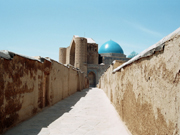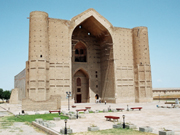| |
THE TIME OF JOLLY MISSIONS,
OR COMBINING BUSINESS AND PLEASURE
BREATH OF MILLENIUMS
(Turkestan City)
Not without relief we left Shymkent and set off for Turkestan. The land of South Kazakhstan is rich in sacred places, but no one will argue that the championship in this sense belongs to Turkestan and Mausoleum to the famous Sufi saint Khodja Akhmed Yassavi situated in it.
 |
A street of ancient Turkestan with Mausoleum in the background |
Architecture is indeed the only arts I really respect. And, if it is ancient and also monumental then the creation is to succeed with me at once. This happened with Turkestan , more precisely with its famous Mausoleum. First, from the distance, I was attracted by its blue cupolas; then I was walking enchanted along its halls and corridors, obviously feeling the ancient atmosphere imbuing every square centimeter of its walls.
People who are more pious than I saw something different in the Mausoleum. Numerous pilgrims were busy passing it around, touching the ancient walls and saying their prayers.
One may walk long in the Mausoleum, viewing gravestones and scriptures on the walls, studying its numerous rooms. The main and the biggest one is called ‘jamaatkhana’. It is a big hall for gatherings, which connects all the other rooms of the mausoleum. At the ancient time it was designed for dervishes to conduct their rites there. The central element of the hall is a huge cauldron (that is why the hall has another name ‘kazanlyk’ – ‘ kazan’ is ‘a cauldron’ from Kazakh). The Sufis thought that the cauldron symbolized unity and hospitality. Perhaps, to show how glad they were to see the guests here, they created a really immense cauldron for the Mausoleum – over 2 meters in diameter.
 |
Portal of Mausoleum |
The saint Sufi’s ashes rest in the burial-vault situated next to the meeting hall, under the imposing gravestone, tiled with green plates of serpentinite.
The Mausoleum (though in modern literature the complex is more often referred to as ‘khanaka’) is the miracle of seismic stability. And though it looks like a whole, its total volume is indeed divided into eight independent blocks. That is why the building could go through earthquakes and wars.
Turkestan has for a long time been a sacred place for the Kazakhs. And that is why the fact can be well explained that a great number of people important for the Kazakh history, the most famous among which are khans Yesim, Abylai and Zhangir, and the eminent Kazakh bi (a judge and leader of the clan) Kazybek are buried in the Mausoleum or next to it.
But architecture is not the only thing to distinguish Turkestan . This rather small and quiet town is home for quite the other sort of people than in Shymkent. And this is not only my personal observation. Many people note some isolation, I would even say ‘exterritoriality’ of this place. For some reason the day we spent in the town no one tried to cheat us in counting or in any other way.
But the local weather was not as pleasant. At least, this was opinion of Lena ’s who was literally killed by 38 degrees centigrade above zero in the shade. It was really very hot, even in spite of the fact that we drank a lot of cold liquids of all kinds. In this sense the day abounded in discoveries. For example, we tasted for the first time hot (almost literally) coca-cola, which heated in the sun for half an hour; we also tried a drink with the corresponding to the situation Muslim name – Mecca-cola.
Only when we were sitting on a bench in front of the entry to the complex I recalled the words I was told in one of the tourist agencies of Shymkent, concerning the mausoleum, ‘What will you watch there? It looks unfinished!’ I do not know whether I should cry or laugh after hearing these words. Khodja Akhmed Yasavi Mausoleum is indeed unfinished, but it was ‘unfinished’ by the very Tambourlaine, in the early 15th century. How I want to tell something offensive about such people’s being ‘unfinished’, for they are to attract tourists to Kazakhstan (what is by the way not very difficult in the south, taking into consideration the number of antiquities there) but not to prefer to take Kazakhstani people to Antalia and Emirates.
The railway station in Turkestan, one of the oldest in Kazakhstan, witnessed that night a genuine concert organized by us so as not to be bored in the waiting hall, which possesses extremely good acoustics.
|



